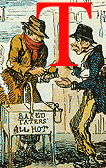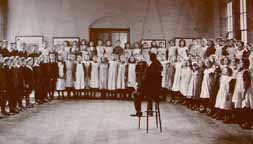(The initial "T" comes from George Cruikshank's Comic Alphabet)

he city that William Cobbett described as a "wen" or growth has spawned countless studies and statistics. No wonder some recent authors like Gillian Tindall (The House by the Thames, 2006) and Rosemary Ashton (142 Strand, 2006) have chosen to write about single London addresses. Apart from the challenges of organising vast amounts of material and presenting a fresh take on it, there is the newer one of finding an appropriate authorial voice. Peter Ackroyd's ambitious London: The Biography (two hundred pages longer even than White's hefty volume) has both that author's marvellous flow and his tendency to dramatise, sentimentalise and mysticise: of the poor, for example, he says, "It is as if the streets themselves engendered these huddled masses"(601). Liza Picard and Jerry White find different ways of rising to such challenges, with the happy result that they complement rather than rival each other.

Liza Picard is a veteran recorder of London life through the ages, and has set herself clear limits: a thirty-year span, covering roughly the first half of the period, and "no novels, no poems" (xviii) as source material. There is a no-nonsense chapter arrangement as well. After an evocative opening chapter on smells, she deals with London's geography (Chapters 2 and 3, "The River" and "The Streets" respectively), its railways, buildings and other "practicalities" (Chapters 4-6), and, most thoroughly, its social history. Here she looks at the various social classes (Chapters 8-11), and many aspects of everyday life such as houses, food, clothes, health, amusements, education, and crimes and punishments (Chapters 12-21). She concludes her enormous roundup with religion and death (Chapters 22 and 23), ending not on a flat note but with the satisfying grand finale of the Duke of Wellington's funeral procession. Here, characteristically, she adopts the stance of a wide-eyed and impressionable observer, making us stand alongside her as the ornate coaches, marching bands, Chelsea Pensioners, colourful heralds and Prince Albert himself pass by, to be followed by a funeral car "the size of small house" drawn by brewery horses. The awkwardness of getting this through Temple Bar and then transferring the coffin to the waiting bier at St Paul's provides some light relief, but, as so often with Picard, the emotive detail comes in at the end:
Following the coffin was the Duke's horse, led by his groom, with those famous boots in the stirrup, facing backwards. The crowds along the route had watched the procession silently, many in tears. As the catafalque passed, they raised their hats in respect. The effect, according to an onlooker, was of the sudden rising from the ground and settling again of a huge flock of birds. (375-76).
Admittedly, much of this comes from Elizabeth Longford's fine Wellington: Pillar of State — including the final sentence, taken from a contemporary letter quoted (and attributed to a Miss A. E. Napier) by Longford herself (449n); still, Picard does say that she drew on Longford's account here, and she has selected from it to good effect.
A Singing Lesson at the Jew's Free School (1908). Courtesy of the Jews' Free School. [Click on thumbnail for larger image.]
A familiar tale entertainingly told, then? To some extent, yes. But Picard sheds light into some quite obscure corners. In Chapter 19 on education, for example, she tells the story of Moses Angel, a story that brings together some of my own interests in this area, but was quite new to me. A brilliant pupil at University College School in Bloomsbury, Angel overcame a family scandal (his father had been transported for robbery) to become the revered Headmaster of the large Jews' Free School in the East End. This grew to an astounding 2,400 pupils by 1870. Indeed, according to Gerry Black, it would eventually top 4,000 under Angel's leadership, becoming probably the largest school in the world. Matthew Arnold, in his role as Schools' Inspector, was greatly impressed by it. When Picard shows Angel at the roadside, picnicking with his army of pupils after a school outing to the British Museum and the Surrey Zoological Gardens, we too pause to admire this man who did so much to integrate immigrant Jewish children into the mainstream of English society.

As it happens, this is the ideal place to turn to Jerry White. White is more ambitious than Picard, charting the whole century. This means he has to divide some of the topics in his five main sections ("City," "People," "Work," "Culture," "Law" and "Order") into periods, so that he can move not just across the spectrum but forward to the twentieth century as well. He also moves geographically, with street and place names featuring among his chapter headings, and since he has a penchant for intriguing sub-headings like "The O. P. Dance" ("O. P." standing for "Old Price," a reference to a protest against raised ticket prices at the new Covent Garden Theatre), this all gets a bit cumbersome. Be that as it may, in "Part Two: People," Chapter V ("Wentworth Street: The London Medley") White too mentions the Jews' Free School a couple of times. The difference is that these are just passing references in a sweeping and often moving analysis of the East End's medley of immigrants. The mixture included poor Irish seasonal workers, exiled French Catholic priests, German merchants, clerks and artisans, Spanish and Italian refugees, Russian, Polish and Austrian Jews (towards the end of the period, and so outside Picard's parameters) and the more exotic and marginalized groups who drifted in from the docks. In the last section of this part, entitled "The London 'Ghetto,'" White details the expansion of the Jewish population from about 20,000 at the beginning of the century to about 140,000 by the end. He discusses its class make-up (only a relatively small proportion was lower-class) and distribution, and argues that it was cohesive despite its divisions as to ritual and location; and he shows how the massive increase in numbers during the last two decades led to a rise in anti-Semitism. Sadly, it also led to the (with hindsight) wretched decision by the Jewish Board of Guardians to repatriate as many as possible. White estimates that 26,000 or more people were sent back to Eastern Europe alone in this period (156). Again, this was news to me, and, while Angel Moses himself is not named here, I now understand the context in which he was working.
White has even more clutches of amazing statistics about London than Picard, but he is never simply amazed by them. He explores them, searches out the larger context that helps to explain them, considers the views of other historians, and reaches his own conclusions. He is particularly good on places. In "Part One: City," he moves from the old London to the new, both chronologically and geographically, out to the suburbs — an enormous area to cover, in every sense. But every major development is held up to the light. For instance, what was Nash's "social purpose" in locating what was to become Regent's Street, who paid for the work, why was his "majestic vision" cut short (25), what was its impact and how was it regarded? Social purpose is always important to White. Another example, from many: why was the Rookery in Holborn "the first bastion of the poor to fall" (31), and what happened to the inhabitants when Nash's pupil, James Pennethorne, was unable to carry through the original plan for this? Old maps are useful reference points here, and White includes seventeen of them. And why, despite the grand, spacious building schemes and the slum clearance did the population continue to skyrocket? White is excellent on suburbia. Is it true, he asks, that the "suburb was a highly efficient means both of functional and social segregation" as Donald Olsen, a specialist in town-planning as well as Victorian London, claims? Not really, he decides, looking at the 1891 census and a variety of other sources to prove it. One can see why White won the Wolfson History Prize of 2001 for his book on London in the twentieth century.
If White's study is denser and more challenging than Picard's, and more meticulously referenced (with seventy-five pages of endnotes to Picard's forty-five, and a massive bibliography as well) it is by no means dry or stolid. His account of the cruelty at the Smithfield livestock market in "Part Three: Work" is particularly harrowing:
Torturing them with goads, hitting them with thick staves on the head and nose, cracking their hocks and twisting their tails to bring their heads up, almost strangling them with tethers and sometimes breaking off a horn and blinding the animal in blood, the drovers had to use every violent means to get the animals to stand nose to nose in a tight-wedged ring. (189).
Despite the string of parliamentary enquiries listed here, a new market dealing in dead-meat was not established until 1868. Like factory reform, too slow, too slow! White's pursuit of many topics through time and place in Victorian London makes us realise afresh that civilisation is a bitterly fought, on-going process.
Indeed, more than Picard's kind of reportage, more even than the simple idea of expansion, this is White's concern — his thesis, if you like. It is the less surprising, then, that he concludes his mammoth study in "Part Five: Law and Order" with an accolade to the not-much-vaunted London School Board:
of all the civilising influences on the Londoner at the century's end it seemed the London School Board was the biggest. In "humanizing" the "poor and degraded people," wrote Charles Booth, "the influence of the schools is greater than that of the churches." He might truly have said, greater than anything else too. Most certainly greater than the poor law. And the police, their reprimands more resented than respected. Greater too than the hospitals, their humanity not yet throwing off the taint of charity and the pauper's dues; and even the ever-enlarging public sphere, civilising the smell and sight of London through sewerage, street improvements, public buildings, transport, greenery, amusements. (475)
Remembering that enlightened and indomitable people like Thomas Huxley and Elizabeth Garrett Anderson sat on this board at various times, and remembering also the great good done by one headmaster (Moses Angel) alone, I am inclined to agree with him.
References
Ackroyd, Peter. London: The Biography. London: Vintage, 2001.
Ashton, Rosemary. 142 Strand: A Radical Address in Victorian London. London: Chatto & Windus, 2006. 386 + xiv pp. £20.00. ISBN 0 7011 7370 X (from January 2007, ISBN 13 9780701173708).
Black, Gerry. "Angel, Moses (1817-1898)." Oxford Dictionary of National Biography. Online ed. Viewed 15 April 2007. (Black is the author of The History of the Jews' Free School since 1732 (1998) to which Picard refers).
Jackson, Lee. A Dictionary of Victorian London: An A-Z of the Great Metropolis. London: Anthem Press, 2006. 338 + xiii pp. £12.99. ISBN 1 84331 230 1.
Longford, Elizabeth. Wellington: Pillar of State. London: Weidenfeld and Nicolson, 1972.
Picard, Liza. Victorian London: The Life of a City, 1840-1870. London: Phoenix, pbk ed. 2006. 444 pp. with 45 illustrations, including two maps. £8.99.
White, Jerry. London in the Nineteenth Century: "A Human Awful Wonder of God." London: Cape, 2007. 624pp. with 35 illustrations and 17 maps. £20.00.
Last modified 12 September 2004
